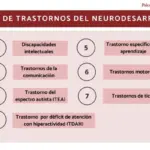After the discovery and establishment of psychometric and factorial methodology in the study of intelligence at the beginning of the last century by Alfred Binet and Simon (1905) and later, Terman (1916) and Weschler in the 1930s, the IQ passed to be the central factor in the evaluation of intellectual capacity.
However, the most recent proposal from the American Association on Mental Retardation (AAMR) of 1992 seems to overcome some of the drawbacks that the first formula was associated with.
Intellectual Disability as a Neurodevelopmental Disorder
A Neurodevelopmental Disorder (or Neurodevelopmental Disorders, according to the DSM-V) is understood as any disease related to an alteration during the maturation process of the nervous system which results in inadequate functioning at the level of behavior, thinking, movement, learning, perceptual-sensitive capacity and other complex mental functions.
The set of manifestations that can occur as a consequence are of a very considerable variety, since attention must be paid to both the location of the dysfunction, the influencing environmental factors as well as the moment of development in which said alteration occurs.
Neuroscience is the discipline that is responsible for the study and research of ODD, as well as other neurodegenerative disorders, static injury disorders, and psychiatric disorders. In certain cases, the same pathology can be considered within more than one of these categories which differ from each other around two dimensions: time (development-decline) and phenomenological (cognitive-emotional).
Its characteristics
Among the characteristics attributed to ODD, there is the difficulty of distinguishing whether the origin of the external manifestation of the underlying symptomatology is derived from an ODD or from a type of normative functioning, such as the case of distractibility ( which may be due to an impairment of the structures that regulate attentional capacity or may simply be a marked personality trait).
So, no biological markers are known (neuroimaging tests or analysis) from which ODD can be diagnosed unequivocally. The subjectivity of the evaluator therefore plays a significant role in the diagnosis made of the case.
In second place, NDD have a very high comorbidity with other pathologies a fact that on certain occasions can make an exact diagnosis of the case difficult since all the labels present must be detected. On the other hand, the delimitation between the symptoms attributable to one disorder and another is also complex, since many of them share common criteria (for example, difficulty in social relationships in a case of autism and a language disorder).
Types of Neurodevelopmental Disorders
In a generic way, TNDs can be classified into three main categories based on the criteria:
Whether or not a specific cause is identified
In this case, genetic influence is a significant causative factor. The most widely used classificatory manuals (DSM and ICD) include communication disorders, learning disorders, hyperactivity disorders, and autism spectrum disorders. In the case of behavioral disorders, schizophrenic disorders and Tourette’s disorder, the difference in age of onset for each of them must be taken into account, so depending on the case they can also be included in this first category.
Genetic alterations linked to a structural alteration
Easier to delimit, since the phenotypic deviations are clearly identifiable (deletion, duplication, translocation, chromosomal disomies or trisomies, etc.), as in the case of Williams Syndrome.
TND linked to a known environmental cause
Its influence is usually considered in interaction with genetic factors, for example fetal poisoning due to maternal alcohol consumption or pathologies derived from the action of valproic acid.
The traditional conceptualization of Intellectual Disability
As indicated at the beginning of these lines, the last century was marked by the rise of psychometric scales for the assessment and quantification of the level of intelligence in human beings.
Thus, the only determining reference was taken to be distinction between the classification levels of Intellectual Disability based on the individual’s Intelligence Quotient (IQ). Let’s see a more detailed description of each of these categories:
Mild Mental Retardation
Understand an IQ between 55 and 70 and presents a proportion of 85% of the total cases. Being the least significant level in severity, it is difficult to distinguish in the first years of life. In this case, social and communicative skills or the capacity for atony are rather preserved, although they require a certain type of supervision and monitoring. No major difficulties are observed in achieving the development of a satisfactory life.
Moderate Mental Retardation
A second level of greater severity with a prevalence of 10% is Moderate Mental Retardation, to which an IQ between 40 and 55 is attributed. In this case the level of social and communicative development is lower and they must be protected during adult work and personal life, although they can still adapt to community life in most cases.
Severe Mental Retardation
Severe Mental Retardation is associated with an IQ between 25 and 40 and occurs in 3-4% of total cases. His linguistic ability is very limited but are capable of acquiring basic self-care habits. They need a considerable level of support and help to adapt to community life.
Profound Mental Retardation
Profound Mental Retardation is characterized by an IQ of less than 25 and is present in between 1 and 2% of the population with MR. At this level we observe clear and serious motor, sensory and cognitive difficulties. They require constant and permanent supervision and a high level of structuring of the environment in which they interact.
The descriptive dimensions of intellectual functioning
The most recent proposal from the American Association on Mental Retardation (AAMR) implies a drastic change in the conception of intellectual disability and places emphasis on providing the definition of Mental Retardation a somewhat more positive and optimistic connotation in terms of mainly assessing the capabilities and potential of the individual with intellectual dysfunction, as well as the support they need to achieve these goals.
Thus, the AAMR’s proposed definition of Mental Retardation explains it as a series of substantial limitations in intellectual functioning, which is significantly below average and which manifests before the age of 18.
Dimensions of evaluation of Mental Retardation
Specifically, the large dimensions proposed by the AAMR on which to assess at a functional level the abilities available to the child and that can be reached with a global multidisciplinary intervention :
Unlike the previous ones, in this proposal there is an emphasis on the social context and on determining what resources are required to guarantee the greatest number of learning, autonomy and well-being of the child in their daily life, instead of taking as a central factor the deficits and difficulties that the child presents.
This brings various advantages both in terms of reducing the negative labeling that is usually associated with individuals who present this type of deficit, since the definition gives a main role to the potentialities and capacities to be developed by the child. Furthermore, this new definition s****e is more focused on determining the type of intervention that will be necessary for the specific case to obtain the highest level of development possible (environmental, social, personal and intellectual adaptations).
In this new conception, the following postulates are presupposed: the consideration of cultural and linguistic, communicative and behavioral diversity; the need for the existence of individualized support at the community level; the co-existence of potentialities in other adaptive areas or personal capacities; the assumption of improvement in the person’s functioning by providing appropriate supports over a sustained period of time.
In short, it seems that the most recent definition of Mental Retardation aims to provide a more practical, positive and adaptive perspective which will facilitate greater integration of the individual both on a personal and social level, enabling greater development by emphasizing their qualities rather than their difficulties.









